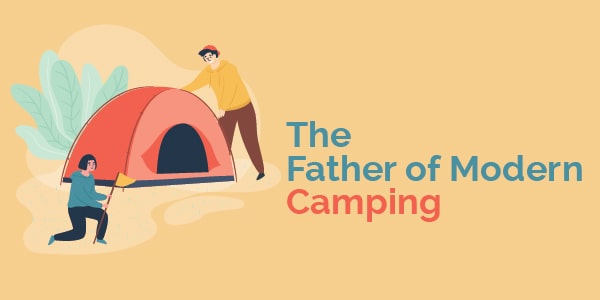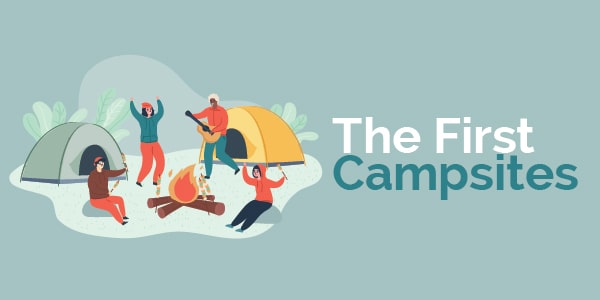When it comes to camping, people have very fixed opinions – they either love it or hate it.
And, even if they have never actually been camping, there are plenty of people who declare that it is not for them.
However, camping is becoming increasingly popular as people look for ways to escape from the stresses of their everyday life and get back to nature. Since 2014, there has been a staggering increase of 72% in the number of campers who camp several times a year and in 2018 1.4 million UK households joined the camping bandwagon and camped for the first time.
Camping for recreation is still a relatively new concept.
It was first made popular during the late Victorian times when it was the pastime of the younger generation rather than the family activity that it is today.

The Father of Modern Camping
It is widely argued that a British travelling tailor, Thomas Hiram Holding, is the father and founder of modern camping.
As a child, he spent some considerable time with his parents crossing much of the United States, including the American prairies, in a wagon train enroute to the Oregon Territory.
This gave him some insight and fostered a love of the outdoors and camping from a very early age.
By the time he was a young man, he was very well travelled.
During the 1880s he went to Scotland on a camping trip, taking with him a canoe.
This was followed by a trip to Ireland where he went camping and cycling.
In 1908 he wrote the very first edition of “The Campers Handbook”, and he also founded the Association of Cycle Campers in 1901.
Initially, the group only had 13 members, and only 6 of them attended the first meeting that was held.
However, the membership contained some very important names with Captain Scott, the explorer and Baden-Powell, the founder of the Scout movement being key members.
The association later became known as the Camping and Caravanning Club.
The name change reflects the changes in camping that took place over the years as caravans became more commonplace and some people choose to ”upgrade” to caravans but wanted to still visit the same sites that were associated with the club.

Camping Associations
In addition to the Camping and Caravan Club, which was founded in 1901, there is one other main association in the UK. Founded in 1907, The Caravan Club of Great Britain and Ireland was created to bring together those people who were interested in caravan life as a recreational activity.
The aim of the club at the time was to help supply vans and other equipment as well as producing lists of suitable campsites.
The club has also changed its name over the years, in 1959 it became The Caravan Club, and in 2017 it changed to The Caravan and Motorhome Club to reflect the growing number of members who owned motorhomes rather than caravans.
Other countries also have their own camping associations offering similar benefits to their members, with a common goal of producing a list of campsites that have been vetted for their facilities in order to help their members to get the best out of their camping experience depending on what requirements they might have.

The First Campsites
It is believed that Cunningham Camp, which is located in Howsteake, on the Isle of Man was one of the first campsites that opened in around 1894.
Initially, the campsite was only for male campers and only open for the summer season, however over the years it quickly expanded both in terms of visitor numbers and size.
By the end of the 1900s, it is believed that over 600 people per week visited the site.
Four acres of land were added to the site in 1904 in order to accommodate a further 1500 tents and a 100-foot marquee which was used as a dining hall.

How has camping grown?
The popularity of camping has seen significant increases in popularity over the years; the only pause to this growth was during World War One.
The 1930s saw a huge boom in the field with the ideas of being more in tune with nature and getting healthier, pushing the idea of camping as an activity.
1932 saw the founding of the first international camping association.
Many of the first campsites offered campers ready pitched tents and facilities, and it wasn’t until more people started to own cars that the idea of owning your own tent became a more widely accepted concept.
Until the 1950s and early 1960s, the most popular choice of holiday for most people was the boarding house.
However, the rigid rules and lack of freedom to come and go as you please, combined with improvements in the quality of camping gear that was available saw camping’s popularity increase significantly.
Tents were much lighter than they had previously been, although still much heavier than they are today, and offered more freedom.
For those people who owned cars, still relatively few, the caravan became a viable alternative for camping.
The 1970s saw more people moving away from the boarding house style holiday in favour of camping not just in the UK but on a global scale.
The iconic VW camper, first created in the late 1940s, also saw an increase in popularity during the late ’60s and early 70’s, leading to it often being referred to as the hippie bus.
In recent years camping has seen two big increases, the first is the rise of the festival which has attracted thousands of people to camping, in many cases for the first time.
Secondly is, of course, glamping, the concept of camping with a more glamourous nature.
Glamping was created to attract those people who, in theory, like the idea of camping but do not want to give up their comforts of home such as proper beds and all the mod cons they feel they need.
Camping has never been a more popular choice when it comes to holidaying, and while campsites do still have rules for their guests they offer a significantly greater level of freedom.
In addition, camping holidays are something the whole family can do together and of course are relatively inexpensive.

Based in Liverpool, Sophie Bray is the Senior Editor at Camping Sites in Britain. Previously she has worked for The Huffington Post. Sophie is a graduate of English Literature at the University of Manchester.



